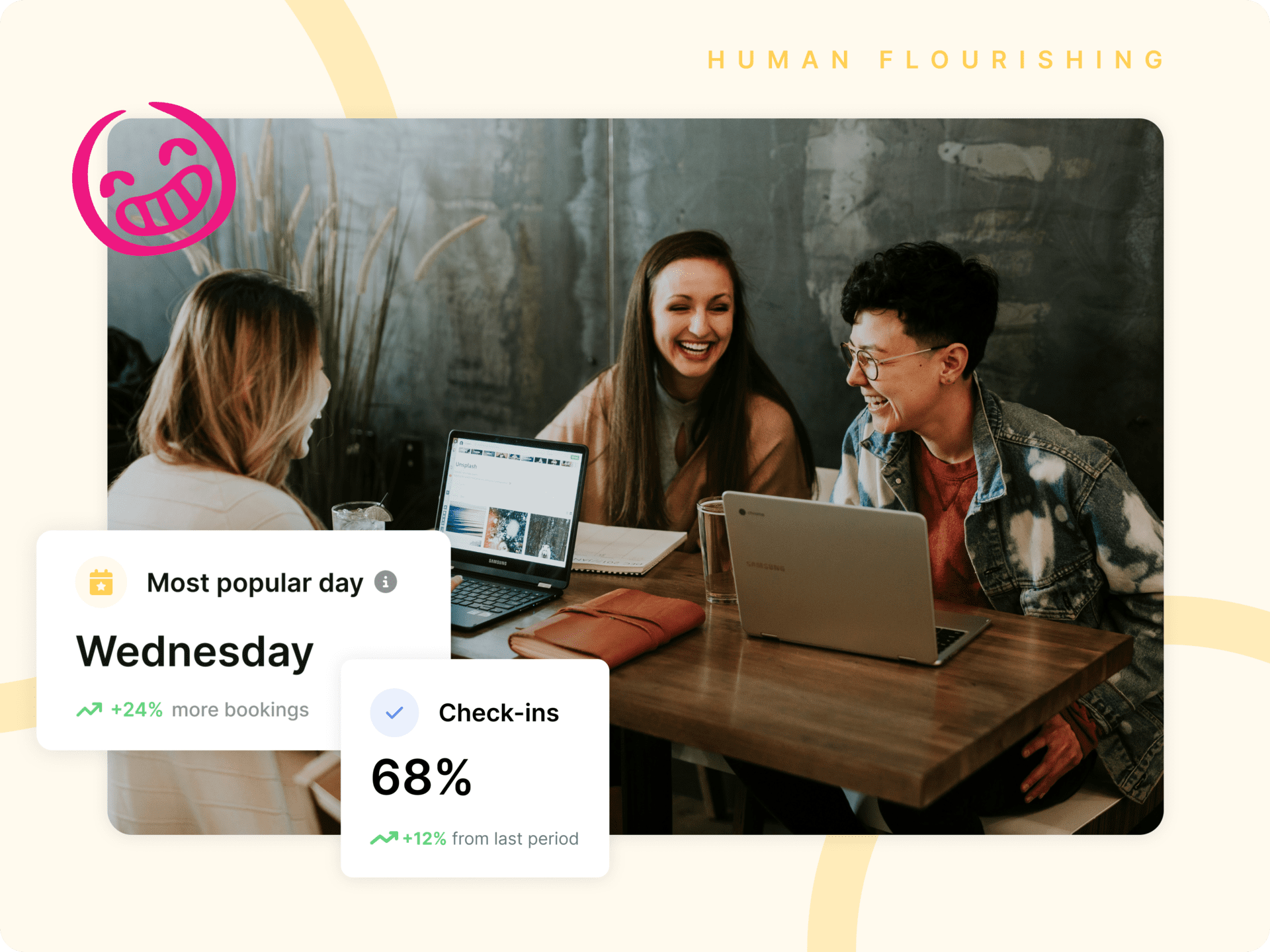Dynamic Office Neighborhoods: Hybrid Work’s Best Kept Secret
In this article you’ll find information about:
- What dynamic office neighborhoods are
- Choosing the right Hybrid work tool
- How to establish office neighborhoods
- The impact of office neighborhoods on community building
- The impact of office neighborhoods on productivity and efficiency
Let’s imagine you’re a business owner looking for ways to optimize your company’s operations in a challenging year. (Maybe you are that person already?)
In those shoes — keeping your team happy and productive is top of mind. The success of your business depends on building a strong community.
So you’ve got a few weapons in your arsenal: team-building retreats, hackathons, workshops, even a well-thought-out system for hybrid work.
What if I told you I could add one more weapon to that arsenal that would totally transform your community-building efforts? A productivity hack you never even knew existed?
Welcome to office neighborhoods — the working world’s best-kept secret.
What is an office neighborhood?
An office neighborhood is, essentially, a micro-community within your physical office space.
With so much variability and unpredictability in office attendance these days, office neighborhoods are designed to bring people together based on shared interests, projects, or goals – so that the time spent engaging in face-to-face work is used as intentionally as possible.
There are several ways to mark out neighborhoods, depending on what you want to get out of them:
- Departmental neighborhoods: putting marketing/sales/engineering together. This is particularly useful for smaller teams that haven’t yet broken out into cross-functional work.
- Project neighborhoods: grouping by projects. This works well for larger companies with a lot of cross-functional project work.
- Activity neighborhoods: marking out people who require or prefer certain working conditions for their job (on an as-needed basis). This could feasibly be a group of desks occupied by an engineer, marketer, product manager, and operations manager – each working on their own projects, yet each requiring deep focus/quiet work in that particular week/month.
- Functional neighborhoods: a community of employees that need access to certain amenities and office features — printers, meeting rooms, double monitors, etc. This could also apply to a group of new hires who are going through the onboarding process together.
Designating the right office neighborhoods will play a key role in the community-building and optimization efforts of your organization. More on that later!
Before you start: Choose a hybrid work tool
The first step to establishing office neighborhoods is choosing the right tool for Hybrid work.
Hybrid work tools help you organize the daily influx and outflux of your employees to the office, and ensure everyone is on the same page when it comes to their work Kadences.
A fully equipped hybrid work tool will enable you and your employees to:
- Book desks in your office, on a regular or ad hoc basis (no more uncertainty about where your workstation will be!)
- See when relevant team members (or “starred colleagues”) have booked office time, so it’s crystal clear when you should come in
- Get notified of last-minute changes to bookings, so you never waste another commute
- See how busy the office is on different days of the week, so you know how to fit the office into your own schedule
The result of implementing a tool for hybrid work is 100% oversight of office attendance — and this transparency extends to every single employee in your organization.
You’re now in the best possible position to start planning how different areas of your office are used to maximize community building. Achievement unlocked: potential for office neighborhoods.
How to establish dynamic office neighborhoods
Once you’ve spent some time implementing a tool that will act as your trusty companion for hybrid work, you’re in a place to carve out different neighborhoods according to your specific community building and productivity goals.
Here are some tips when it comes to designating neighborhoods:
Identify zones for activity neighborhoods
As already mentioned, certain employees will feel better suited to physical areas that help them achieve a certain goal. Take stock of your physical office space and consider where the “activity neighborhoods” may be — whether that be the quietest corner of your office for deep work, or a space where sales representatives can hop on calls without disturbing others.
Mark out neighborhoods for their social and functional value
Is there a part of your office where all of the printers and photocopiers are? Are there a bunch of desks right next to the kitchen area – where people are constantly popping in and out? Make sure you label these areas according to their social and functional properties – so you know which employees will fit best with their energy.
Kadence Top Tip: A well-equipped hybrid tool will also let you mark out where all the important office amenities are — making it easier for employees to find and book the right desks before they go in.
Customize neighborhoods with nice touches
Once you’ve spent some time carving out the different neighborhoods your office has to offer, it’s time to get creative. How can you accentuate the primary function of each neighborhood? Little touches can go a long way to making your employees feel like their neighborhood is tailored to their needs — think sound insulation for constant callers, white noise machines for deep focus, and – of course – a generous smattering of plants all round.
Name your neighborhoods!
This is where the fun starts. Give your neighborhoods fun names (the punnier/more alliterative the better) to make them feel even more like little worlds inside your office. Here are a few ideas:
- Marketing Metropolis
- Numbers Nook (for your finance team)
- Personnel Plaza (HR)
- Creative Corner
- Focus Forum
- Tech Town
- Innovation Island
Survey your employees — where do they feel they belong?
Most importantly of all, you should make sure you have a solid understanding of each of your employees’ unique needs. Consider sending out a survey or questionnaire to gauge interest in specific kinds of neighborhoods. This will help you further refine and mark out the neighborhood areas you have in mind for your workforce.
The deep impact of dynamic office neighborhoods
Whew. You’ve done it. You’ve learned all about the different kinds of office neighborhoods, and how to implement them properly, and you’ve just put those learnings into practice.
Your office neighborhoods are all set up. What can you expect?
Community building comes easily
In the age of post-pandemic work, it’s become even harder than before for business leaders to feel like they are building a strong sense of community in their companies. Office neighborhoods are the hack that stimulates community building on several dimensions.
Belonging and connection
An office neighborhood can instill a real sense of belonging in employees — especially those who have gotten used to spending a lot of time working in isolation at home. Not only does each employee feel like their own unique needs are catered for — they also benefit from having like-minded colleagues close by. This fosters a level of connection that previously didn’t have a sustainable platform. Connection is vital to community building, and employees feeling fulfilled and satisfied in their workplace.
Diversity and inclusivity
Office neighborhoods are flexible, ever-changing workspaces that bring together colleagues on multiple grounds (not purely departmental, as we so often see companies doing). The result of this is the natural grouping together of individuals with diverse backgrounds and skill sets. Providing unique spaces for such colleagues to connect, collaborate, and contribute only enhances a company’s sense of inclusivity — and subsequently empowers it to build an even stronger, more creative, and more innovative community.
Supporting work-life balance
Without office neighborhoods, it could easily feel to employees like there is no real advantage to working from the office — why waste a commute on a physical space that neither inspires them to do work nor connects them with the right people to make things happen? Office neighborhoods remove that question entirely — building a community where employees can control their work-life balance more effectively than ever, and understand more clearly the specific benefits of remote and in-person work.
Your company’s productivity and efficiency will soar
On top of the clear gains you’ll experience for your company’s community-building mission, office neighborhoods will also be a crucial factor in stimulating productivity and efficiency in your employees.
Intentional in-person work
It’s all very well enforcing in-person work – as many large organizations have begun to do – but this approach can be very ineffective when it’s not paired with the right system and infrastructure.
Office neighborhoods ensure that employees are coming into the office for the right reasons — knowing that the space set out for them is one where they can thrive — and be more productive. Laying down a clear intention for your employees when it comes to office-based work is fundamental to ensuring that their commute is not wasted.
Multilateral collaboration
The real wonder of office neighborhoods is how they foster collaboration on so many levels. As already seen, a neighborhood doesn’t need to be set up for people working in the same team or department — it can be a collection of people united by their working style, or the tools they need to be successful.
That means that collaboration is multilateral — from conventional round-the-monitor chats with direct team members to brainstorming sessions involving people from different departments. Make sure to pick a hybrid tool that allows you to see where teammates are sitting – so you can book a seat right by them and collaborate even more intentionally and effectively!
Smart office use
Understanding how your office space is used, and molding neighborhoods to the needs of your employees, inevitably means getting smarter about how efficient your physical space is. Once you’ve gone through the steps in this article, you may find that there are whole pockets in your office that are made redundant, or less important than you thought.
This could mean you choose to downsize your space (thus significantly reducing your monthly real estate costs), or just repurpose it to deliver even more value to your employees and your business. A smart office is one where the space is efficient both from a cost perspective and also a productivity perspective.
“Energy efficiency has been a huge focus for us. With Kadence, we’re able to get a clear overview of how much of our workplace is being used and the future demand for it; and how spaces can be reconfigure”
– Workplace Experience Director, Softchoice
If you’re a business leader, I’m sure you have a million things on your to-do list when it comes to working through your productivity and community-building goals this year.
I hope I’ve managed to persuade you that office neighborhoods could be the key to unlocking the health of your community in a post-pandemic working world — and how it’s that tidy little hack you’ve been on the lookout for.
Hybrid work is here to stay, and the more we come up with ways to capitalize on the endless flexibility it affords us, the more we can foster stronger, happier, and more productive teams than ever before.
To explore how Kadence can transform your team collaboration at your workplace, book a demo and see it in action.




